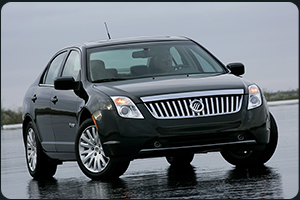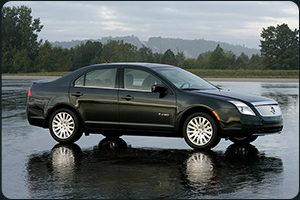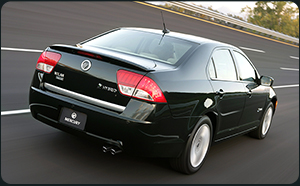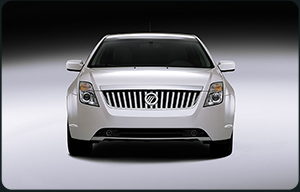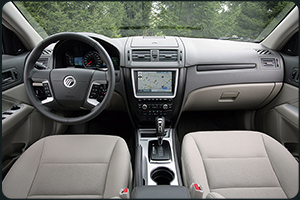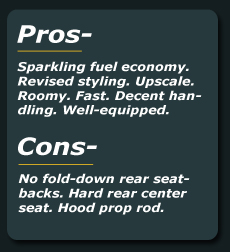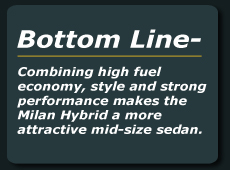2010 Mercury Milan Hybrid
Price: $27,500
The Mercury Milan reminded me of a good foreign sedan when it arrived
several years ago, and the improved 2010 model makes this classy
mid-size car an even more viable competitor.
The Milan is basically an upscale version of the popular Ford Fusion.
Non-hybrid Milan models come with a 2.5-liter 175-horsepower
four-cylinder, which has an EPA-estimated, improved 22-31 mpg city
rating and 23 and 34 highway rating despite a 15 horsepower increase
from 2009. It works with a six-speed manual or automatic transmission,
up from five speeds in 2009.
There's also a fairly economical 3-liter, 240-horsepower V-6, which is
up19 horsepower from its predecessor.
Prices of these well-equipped Milans range from $21,180 to $27,800,
with the top-line V-6 Premier version having an all-wheel drive system
for better traction. Other Milans have front-wheel drive, including the
$27,500 Hybrid, which has subtle "hybrid" badging.
The fast, roomy Milan Hybrid delivers an exceptional, estimated 41 mpg
in the city and 36 on highways. It now can be driven longer at higher
speeds in electric mode. For example, this Mercury can operate up to 47
mph in pure electric mode, or about twice as fast as some rivals.
Thus, under the right conditions, a person can drive, say, in city
areas or mall parking lots without using a drop of gasoline. The city
driving range on a single tank of gas is estimated to top 700 miles.
When a gasoline stop is needed, the capless fuel filler comes in handy.
The gas/electric powertrain provides fast merging onto freeways and
strong 65-75 mph passing on highways. It works with a smooth,
responsive continuously variable automatic transmission.
The second-generation hybrid powertrain system combines the best
attributes of the car's 2.5-liter, 155-horsepower four-cylinder
gasoline engine and electric battery-driven motors. This propulsion
system, which has a net rating of 191 horsepower, transitions between
gas and electric power and back efficiently and seamlessly.
All new Milans receive exterior design changes that focus on the
grille, fenders, hood and front and rear fascias. The car's "chin" has
been pulled forward, and the fascia pulled down for a wider, sportier
look. These changes, besides underbody work, make the Milan more
aerodynamic and thus quieter and more fuel-efficient.
However, fairly thick windshield posts partly obstruct visibility when
making turns.
Large body color door handles make it easy to enter. The interior--long
a Milan strong point--has major improvements to make it
quieter. And it's given a more contemporary, technical two-tone look
with new metallic finishes on the instrument panel that carry through
on the console, doors and steering wheel.
A new instrument panel with backlit gauges that make them easier to
read in bright sunlight is finished with a soft upper and lower "skin"
to get away from the hard plastic in some rivals. Also, a redesigned
leather-wrapped tilt/telescoping steering wheel, new shifter and
wrapped and padded armrests are added to heighten the Milan's comfort
and sportiness. Seats feature contrasting stitching and leather inserts
to give the car more distinction.
But larger sound system and climate controls would be appreciated. The
glove compartment is only moderately sized, but the covered console bin
is deep and front doors have map pockets and beverage holders. Dual
console cupholders can be easily reached, and there's a shallow covered
bin atop the dashboard to store thin objects and a thoughtful pull-out
coin holder for toll booths to the left of the steering wheel.
Options include a moonroof and upscale sound system with 12 speakers, A
driver's vision package includes a blind spot information system with
cross-traffic alert and a rearview camera.
The Milan Hybrid isn't a sports sedan. But steering is quick, although
it occasionally has a rather dead feel. The turning circle has been
reduced by nearly a foot for better close-quarter maneuvering. The ride
is supple, and handling is good--thanks partly to a nicely developed
suspension and 17-inch aluminum wheels. A traction control system is
standard. The brake pedal has a soft, linear action, with improved
feel.
Front seats are comfortable, with more side support. And the rear seat
is nicely contoured, although the hybrid system design prevents rear
seatbacks from flipping forward to enlarge the cargo area.
The fairly large trunk has a low, wide opening and grocery bag hooks.
Its lined lid opens smoothly on struts. Lacking struts, the hood is
held open by an old-fashioned prop rod.
It used to be that upscale, roomy sedans delivered marginal fuel
economy. Nobody thought.that a car such as the Milan Hybrid would come
along.
